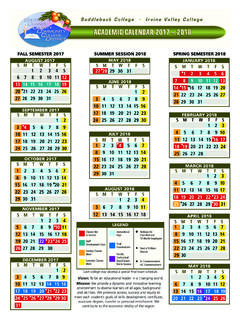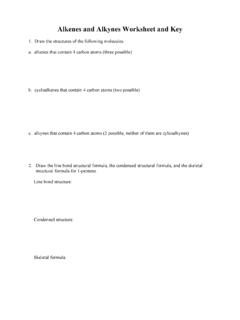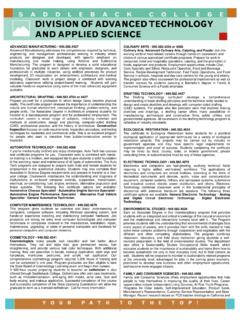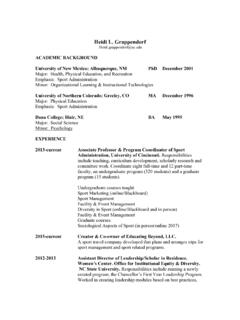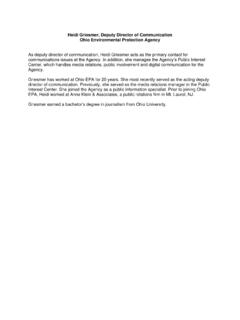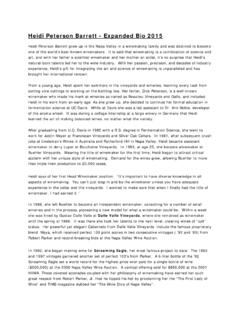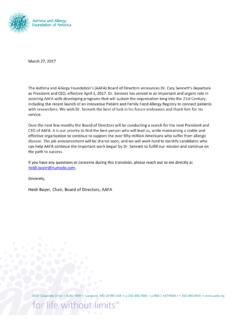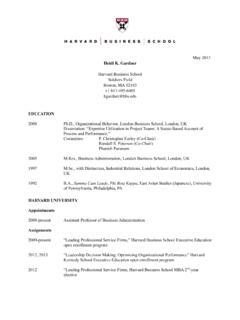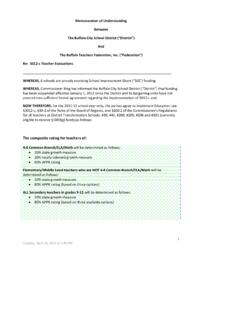Transcription of by Heidi Goodrich Andrade Understanding Rubrics
1 6/20/2014 Understanding Rubrics by Heidi Goodrich Rubricsby Heidi Goodrich AndradeAuthentic assessments tend to use Rubrics to describe student achievement. At last, here sclarity on the time I introduce Rubrics to a group of teachers the reaction is the same instant appeal( Yes, this is what I need! ) followed closely by panic ( Good grief, how can I be expected todevelop a rubric for everything? ). When you learn what Rubrics do and why you can createand use them to support and assess student learning without losing your Is a rubric ?A rubric is a scoring tool that lists the criteria for a piece of work, or what counts (forexample, purpose, organization, details, voice, and mechanics are often what count in a pieceof writing).
2 It also articulates gradations of quality for each criterion, from excellent to term defies a dictionary definition, but it seems to have established itself, so I continue touse example in Figure 1 (adapted from Perkins et al 1994) lists the criteria and gradations ofquality for verbal, written, or graphic reports on student inventions for instance, inventionsdesigned to ease the Westward journey for 19th century pioneers for instance, or to solve alocal environmental problem, or to represent an imaginary culture and its inhabitants, oranything else students might rubric lists the criteria in the column on the left: The report must explain (1) the purposesof the invention, (2) the features or parts of the invention and how they help it serve itspurposes, (3) the pros and cons of the design, and (4) how the design connects to other thingspast, present, and future.
3 The rubric could easily include criteria related to presentation styleand effectiveness, the mechanics of written pieces, and the quality of the invention four columns to the right of the criteria describe varying degrees of quality, from excellentto poor. As concisely as possible, these columns explain what makes a good piece of workgood and a bad one bad. Figure 1 rubric for an Invention ReportCriteriaQualityPurposesThe reportexplains the keypurposes of theinvention andThe reportexplains all of thekey purposes ofthe reportexplains some ofthe purposes ofthe invention butThe report doesnot refer to thepurposes of Rubrics by Heidi Goodrich out lessobvious ones reportdetails both keyand hiddenfeatures of theinvention andexplains howthey reportdetails the keyfeatures of theinvention andexplains thepurposes reportneglects somefeatures of theinvention or thepurposes report doesnot detail thefeatures of theinvention or thepurposes reportdiscusses thestrengths andweaknesses ofthe invention.
4 And suggestsways in which itcan reportdiscusses thestrengths andweaknesses ofthe reportdiscusses eitherthe strengths orweaknesses ofthe invention butnot report doesnot mention thestrengths or theweaknesses ofthe reportmakesappropriateconnectionsbetween thepurposes andfeatures of theinvention andmany differentkinds reportmakesappropriateconnectionsbetween thepurposes andfeatures of theinvention andone or reportmakes unclearor inappropriateconnectionsbetween theinvention reportmakes noconnectionsbetween theinvention andother things. Why Use Rubrics ? Rubrics appeal to teachers and students for many reasons. First, they are powerful tools forboth teaching and assessment. Rubrics can improve student performance, as well as monitor it,by making teachers expectations clear and by showing students how to meet theseexpectations.
5 The result is often marked improvements in the quality of student work and inlearning. Thus, the most common argument for using Rubrics is they help define quality. One student actually didn t like Rubrics for this very reason: If you get something wrong, shesaid, your teacher can prove you knew what you were supposed to do! (Marcus 1995).6/20/2014 Understanding Rubrics by Heidi Goodrich second reason that Rubrics are useful is that they help students become more thoughtfuljudges of the quality of their own and others work. When Rubrics are used to guide self- andpeer-assessment, students become increasingly able to spot and solve problems in their ownand one another s work. Repeated practice with peer-assessment, and especially self-assessment, increases students sense of responsibility for their own work and cuts down onthe number of Am I done yet?
6 , Rubrics reduce the amount of time teachers spend evaluating student work. Teacherstend to find that by the time a piece has been self- and peer-assessed according to a rubric , theyhave little left to say about it. When they do have something to say, they can often simply circlean item in the rubric , rather than struggling to explain the flaw or strength they have noticedand figuring out what to suggest in terms of improvements. Rubrics provide students withmore informative feedback about their strengths and areas in need of , teachers appreciate Rubrics because their accordion nature allows them toaccommodate heterogeneous classes. The examples here have three or four gradations ofquality, but there is no reason they can t be stretched to reflect the work of both gifted andthose with learning , Rubrics are easy to use and to explain.
7 Christine Hall, a fourth grade teacher, reflectedon how both students and parents responded to her use of Rubrics :Students were able to articulate what they had learned, and by the end of the year couldbe accurate with their evaluations. Parents were very excited about the use of parent conferences I used sample Rubrics to explain to parents their purpose, andhow they were used in class. The reaction of parents was very encouraging. They knewexactly what their child needed to do to be Do You Create Rubrics ? Rubrics are becoming increasingly popular with educators moving toward more authentic,performance-based assessments. Recent publications contain some Rubrics (Brewer 1996;Marzano et al 1993). Chances are, however, that you will have to develop a few to reflect yourown curriculum and teaching style.
8 To boost the learning leverage of Rubrics , the rubric designprocess should engage students in the following steps:1. Look at models: Show students examples of good and not-so-good work. Identifythe characteristics that make the good ones good and the bad ones List criteria: Use the discussion of models to begin a list of what counts in Articulate gradations of quality: Describe the best and worst levels of quality, thenfill in the middle levels based on your knowledge of common problems and thediscussion of not-so-good Practice on models: Have students use the Rubrics to evaluate the models you gave6/20/2014 Understanding Rubrics by Heidi Goodrich in Step Use self- and peer-assessment: Give students their task.
9 As they work, stop themoccasionally for self- and Revise: Always give students time to revise their work based on the feedback theyget in Step Use teacher assessment: Use the same rubric students used to assess their 1 may be necessary only when you are asking students to engage in a task with whichthey are unfamiliar. Steps 3 and 4 are useful but time-consuming; you can do these on yourown, especially when you ve been using Rubrics for a while. A class experienced in rubric -based assessment can streamline the process so that it begins with listing criteria, after whichthe teacher writes out the gradations of quality, checks them with the students, makesrevisions, then uses the rubric for self-, peer-, and teacher Tanona, a second grade teacher, went through the seven-step process with her result was a rubric for assessing videotaped Reading Rainbow-style book talks (fig.)
10 2). Figure 2 Book Talk RubricCriteriaQualityDid I get myaudience s attention?Creative beginningBoring beginningNo beginningDid I tell what kind ofbook?Tells exactly what typeof book it isNot sure, not clearDidn t mention itDid I tell somethingabout the maincharacter?Included facts aboutcharacterSlid over characterDid not tell anythingabout main characterDid I mention thesetting?Tells when and wherestory takes placeNot sure, not clearDidn t mention settingDid I tell oneinteresting part?Made it soundinteresting I want tobuy it!Told part and skippedon to something elseForgot to do itDid I tell who mightlike this book?Did tellSkipped over itForgot to tellHow did I look?Hair combed, neat,Lazy lookJust-got-out-of-bed6/20/2014 Understanding Rubrics by Heidi Goodrich clothes, smiled,looked up, happylook, head downHow did I sound?
